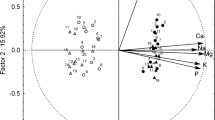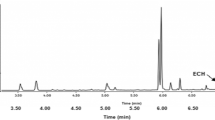Abstract
The content of Cd, Cr, Cu, Fe, Mn, Ni, Pb and Zn was determined in commercially available black and green tea from Sarajevo market. The concentrations of metals in tea infusion and solutions prepared by applying four digestion methods were determined by using FAAS. The results show that the highest concentration of total metals was obtained after acid digestion in an autoclave. The concentration of metals soluble in water obtained in tea infusion does not exceed maximum allowed values provided by WHO (Guidelines for drinking-water quality, World Health Organization, Geneva, 2011). Among the investigated metals Mn was the highest and ranged from 286 to 334 μg g−1 in tea infusion of green and black tea, respectively, to 1,078 and 1,528 μg g−1 total content of Mn in green and black tea, respectively. The concentration of heavy metals in water extracts of tea was distinctly low in comparison with the total content. The concentrations of Cd and Pb were under the determination limit using FAAS. The total content of all determined metals was higher in black tea than in green tea.


Similar content being viewed by others
References
WHO, Guidelines for drinking-water quality, 4th edn. (World Health Organization, Geneva, 2011)
P.L. Fernandez, F. Pablos, M.J. Martin, A.G. Gonzalez, Multi-element analysis of tea beverages by inductively coupled plasma atomic emission spectrometry. Food Chem 76, 483–489 (2002)
M. Soylak, M. Tuzen, A.S. Souza, M.G.A. Korn, S.L.C. Ferreira, Optimization of microwave assisted digestion procedure for the determination of zinc, copper and nickel in tea samples employing flame atomic absorption spectrometry. J Hazard Mater 149, 264–268 (2007)
S. Seenivasan, N. Manikandan, N.N. Muraleedharan, R. Selvasundaram, Heavy metal content of black teas from south India. Food Control 19, 746–749 (2008)
F.K. Gorur, R. Keser, N. Akcay, S. Dizman, N.T. Okumusoglu, Radionuclides and heavy metals concentrations in Turkish market tea. Food Control 22, 2065–2070 (2011)
M.T. Soomro, E. Zahir, S. Mohiuddin, A.N. Khan, I.I. Naqvi, Quantitative assessment of metals in local brands of tea in Pakistan. Pak J Biol Sci 11(2), 285–289 (2008)
D.W. Gebretsadik, B.S. Chandravanshi, Levels of metals in commercially available Ethiopian black teas and their infusions. Bull Chem Soc Ethiop 24, 339–349 (2010)
K.L. Mandiwana, N. Panichev, S. Panicheva, Determination of chromium(VI) in black, green and herbal teas. Food Chem 129, 1839–1843 (2011)
M.A. Herrador, A.G. Gonzalez, Pattern recognition procedures for differentiation of green, black, and oolong teas according to their metal content from inductively coupled plasma atomic emission spectrometry. Talanta 53, 1249–1257 (2001)
F.M. Shen, H.W. Chen, Element composition of tea leaves and tea infusions and its impact on health. Bull Environ Contam Toxicol 80, 300–304 (2008). doi:10.1007/s00128-008-9367-z
S. Nookabkaew, N. Rangkadilok, J. Satayavivad, Determination of trace elements in herbal tea products and their infusions consumed in Thailand. J Agric Food Chem 54(18), 6939–6944 (2006). doi:10.1021/jf060571w
Y. Sahan, F. Basoglu, S. Gucer, ICP-MS analysis of a series of metals (Namely: Mg, Cr Co, Ni, Fe, Cu, Zn, Sn, Cd and Pb) in black and green olive samples from Bursa, Turkey. Food Chem 105, 395–399 (2007)
A.C. Achudume, D. Owoeye, Quantitative assessment of heavy metals in some tea marketed in Nigeria—bioaccumulation of heavy metals in tea. Health 2(9), 1097–1100 (2010). doi:10.4236/health.2010.29162
S. Saud, A.L. Oud, Heavy metal contents in tea and herbs leaves. Pak J Biol Sci 6(3), 208–212 (2003)
M. Yemane, B.S. Chandravanshi, T. Wondimu, Levels of essential and non-essential metals in leaves of the tea plant (Camellia sinensis L.) and soil of Wushwush farms, Ethiopia. Food Chem 107, 1236–1243 (2008). doi:10.1016/j.foodchem.2007.09.058
D.G. Marbaniang, P. Baruah, R. Decruse, E.R. Dkhar, D.F. Diengdoh, C.L. Nongpiur, Study of trace metal (Cr, Mn, Fe Co, Ni, Cu, Zn and Cd) composition in tea available at Shillong, Meghalaya, India. Int J Environ Prot 1, 13–21 (2011)
A. Szymczycha-Madeja, M. Welna, P. Pohl, Elemental analysis of teas and their infusions by spectrometric methods. TrAC Trends Anal Chem 35, 165–181 (2012). doi:10.1016/j.trac.2011.12.005
Council of Ministers of Bosnia and Herzegovina Regulations on maximum permitted levels for certain contaminants in foodstuffs. Official Gazette of BiH 37/09 (2009)
Author information
Authors and Affiliations
Corresponding author
Rights and permissions
About this article
Cite this article
Memić, M., Mahić, D., Žero, S. et al. Comparison of different digestion methods of green and black tea at the Sarajevo market for the determination of the heavy metal content. Food Measure 8, 149–154 (2014). https://doi.org/10.1007/s11694-014-9175-6
Received:
Accepted:
Published:
Issue Date:
DOI: https://doi.org/10.1007/s11694-014-9175-6




